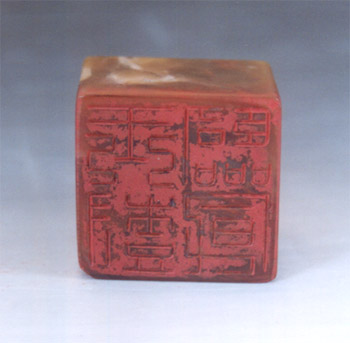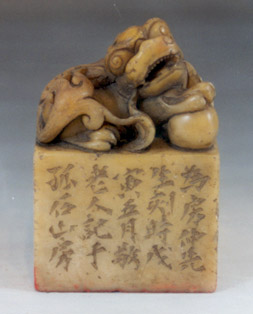 |
| A Ming Dynasty seal made of ox horn (5 x 5 x 5.5cm) |
Seal engraving is a unique art form of Chinese characters. To trace the origin of Chinese seals, one has to relate it to the discovery of the Chinese characters. The most ancient Chinese characters first originated in the Yin Dynasty (i.e., the later period of the Shang Dynasty, from 16th-11th century BC) as inscriptions on animal bones or tortoise shells. Inscriptions on ancient bronze objects appeared in the Zhou Dynasty (11
thcentury - 256BC).
According to records inthe Zuo Commentary on the Spring and Autumn Annals,Xi(royal seal) engraving had emerged in the mid Spring and Autumn Period. In the Warring States (475-221BC), the difference between varied forms of Chinese characters in different states was also reflected on the seals. The Qin Dynasty unified Chinese characters withXiaozhuan(seal script), so the official and private seals handed down after the dynasty almost took seal script as their calligraphy.
 |
| A Qing Dynasty seal (5.2 x 3.6 x 7.7cm) |
Seals in the Qin Dynasty and the Han Dynasty featured diversified styles, and they were either vigorous, or firm and unsophisticated. In the early years of the Western Han Dynasty (206BC-8AD), False Seal Script that curved and winded and Bird-and-Insect Script that took insects, fishes, birds and other animals as it shape were the most often seen scripts on seals. In the Wei (220-265) and Jin (265-420) dynasties, the Hanging-Needle Seal Script characterized by drooping upright strokes with a thin tip came into being. Seals in the Warring States Period to the Tang (618-907) and Song (960-1279) dynasties mostly had practical value, and were used as credence or keepsake. After the Song and Yuan (1271-1368) dynasties, to meet the demand of collection and appreciation of paintings and calligraphic works, some literators seals mainly for appreciation, and various seal engraving styles sprang to life. Great masters of seal engravings in the past generations included Wen Peng, Ding Jing, He Zhen, Deng Shiru, Zhao Ziqian, Wu Changshuo, and Qi Baishi, etc.
The materials used to make seals include jade, copper, silver, ivory, ox horn, pear wood, bamboo root, stone and so on. Seals made of stone are the ones we see the most often.
